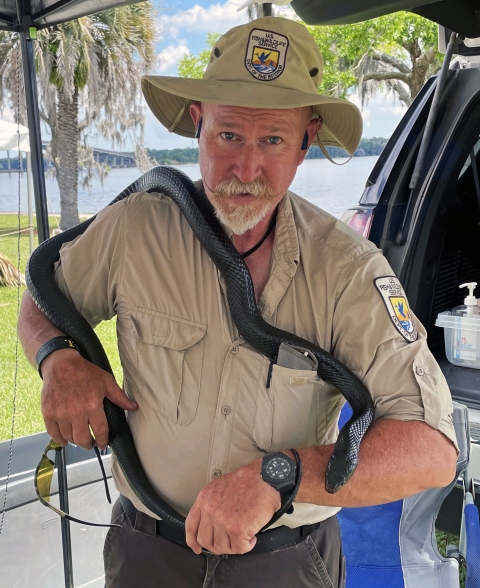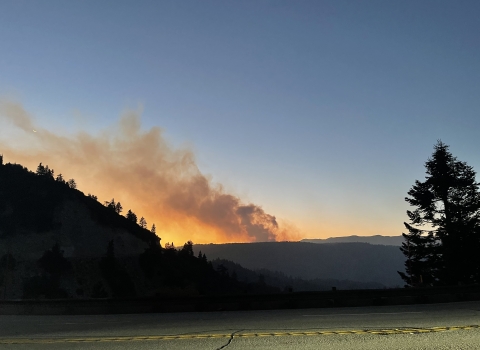What More Can a Fish Hatchery Do?
Located on the St. Johns Riverbank between Jacksonville and Orlando, Fla., Welaka National Fish Hatchery produces Atlantic Striped Bass, Gulf Striped Bass, Channel Catfish, Bluegill, and Redear Sunfish to stock reservoirs, lakes, rivers and coastal streams across the South Atlantic-Gulf & Mississippi Basin.
Tony Brady, a biologist with over 20 years of experience in freshwater mussels and fisheries, faced a new challenge when the hatchery received an unexpected request in 2017 to raise federally endangered eastern indigo snakes. After being the first to propagate endangered freshwater mussels at Genoa National Fish Hatchery, Brady brought his innovative approach to Welaka.
Hotel Indigo
Brady and project leader Ken Blick visited the Orianne Center for Indigo Conservation to learn how to care for snakes and decided to take it on. This marked the first for a fish hatchery.
The hatchery staff removed a 10-foot circular fish tank to make a room within an existing building. They used interlocked refrigerator panels to form walls and put on a roof. It was inexpensive and easily accessible. Workers closed the floor drain and plugged escape points, setting up a room that holds 30 snakes. Each snake has two tubs so staff can move them into a clean tub while cleaning the dirty one. “It is less stressful on the snakes to not be held by hand during the cleaning process,” Brady said.
The first batch of eastern indigo snakes arrived at the hatchery in January 2018. The snakes are about a foot long when they arrive at Welaka as juveniles. They typically grow three to four feet more and gain two pounds during their six-month stay. The hatchery cares for the snakes until they are 18 months old when their chances for survival are the best.
And it is quite a job. Each snake bin is checked daily to see if it needs cleaning. Even the snakes are washed when they are covered in digested waste. Staff feeds them twice a week a diet of thawed quail chicks, mice, rat pups, and occasionally a fresh treat of rainbow trout from Erwin National Fish Hatchery. One thing Brady has learned the hard way: “Do not open the snake bin with your thumb pointing up and over the lip of the bin. It looks like prey, and they will bite it,” he said. “Their needlelike teeth angle towards their bodies and can shred your thumb when you pull it out.
Each snake has its unique personality. “Some are more laid back, while others stay hungry and come across as aggressive,” Brady said. “Snakes are great when the power goes out because you don’t have to worry about them running out of oxygen like you do with fish.”
In 2023 the Orianne Center for Indigo Conservation needed housing for more snakes. The Welaka staff removed another fish tank and built a second snake room for 30 more. Now they can care for up to 60 snakes a year. Since the program kicked off six years ago, the hatchery has cared for 187 indigo snakes including the 59 snakes on site.
Expanding Conservation
Last December, after seven years of releasing these captive-bred indigos at the Apalachicola Bluffs and Ravines Preserve, biologists discovered that the snakes were reproducing, with at least two eastern indigo snakes born in December of 2023. (December 2023 WFSU Ecology Blog)
“That is what conservation is all about,” said Brady. “Reestablishing populations so they become self-sustaining.”
Snake Spa to Bird Bungalow
The hatchery’s work with snakes was so successful, Mother Nature had another job for them. Birds.
Welaka began rearing federally endangered Florida grasshopper sparrows in 2019. A decade ago, the population was on the brink of extinction from habitat loss and other threats. In response, the U.S. Fish and Wildlife Service and partners began to breed them in captivity.
“Really? Fish guys to foster birds?” laughed Brady
After taking a sharp turn from snakes to bird research, he and his staff set out to build a champagne aviary on a beer budget. They bought a carport frame and enclosed it with hardware cloth. Once they enclosed the frame, they covered the seams with metal stripping to keep predators out, and the birds in and protected.
When the breeders deliver the fledglings to Welaka, the parents renest, increasing chick production. On average, they lay four or five eggs at a time. “The batches vary but we can get up to 20 fledglings,” Brady said. The hatchery cares for the birds for about three weeks before they are released into the wild. But biologists needed to release them in various locations, which posed a new challenge. The hatchery staff transformed a woodchip trailer into a mobile aviary. Now they can take the birds to different release locations where they stay the night to acclimate and be released out of the mobile aviary the next day. Since the first group of birds was delivered to Welaka, 241 sparrows have been released with 33 more to go.
The MacGyver Approach to Conservation
Brady said that hatchery staff are wired to solve problems that require creative, novel solutions. “It’s called the MacGyver gene. Duct tape, zip ties, bailing wire, balloons, soccer balls – we make do with what we’ve got,” he said.
You can see the MacGyver approach to conservation in action and these rare and beautiful species at the Welaka National Fish Hatchery, open from 8 a.m. to 3 p.m., Monday through Friday except for federal holidays, or at any of the other 69 federal fish hatcheries around the country.







